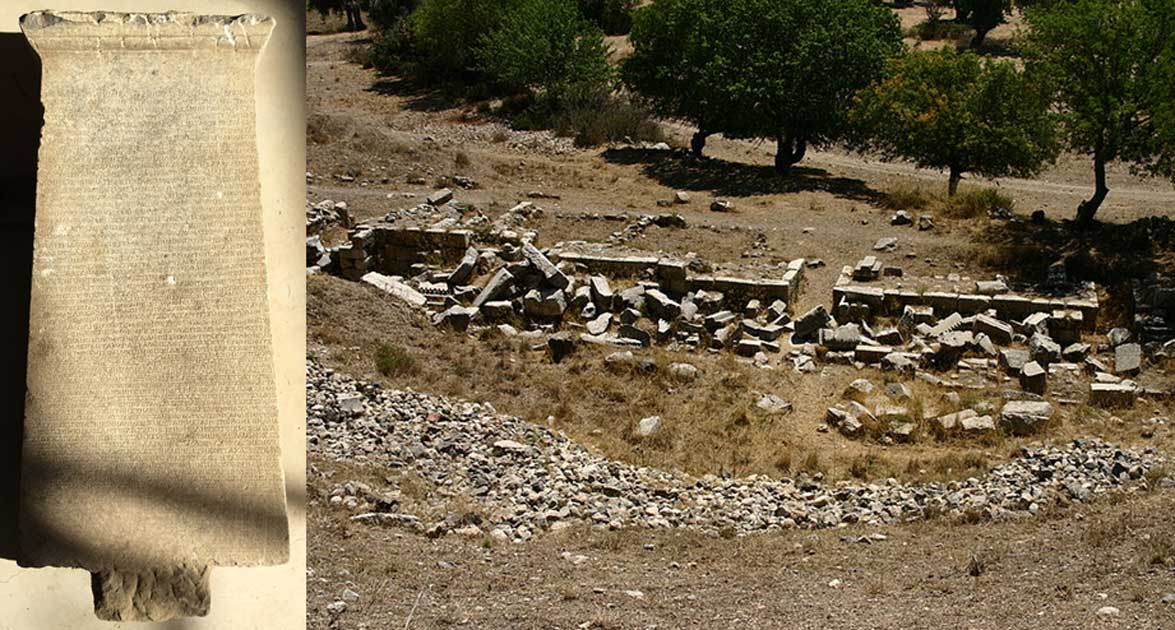Rental Agreement Discovered in Turkey Shows Tenancy Was No Easier 2,200 Years Ago
Archaeologists have unearthed a unique inscription in the ancient city of Teos in the Seferihisar district of Izmir Province, Turkey. The text carved in stone is a rare example of an ancient rental agreement.
According to Hurriyet Daily News, the discovery is thought to be the most comprehensive rental agreement in Anatolian history. The city of Teos was established in 1,100 and is well known from information written by Herodotus. However, the new discovery sheds more light on the history of the city. The rental agreement was apparently made with a guarantor and six witnesses, including notable citizens, and declares punishments against the improper use of land containing buildings.

Odeon of the ancient city of Teos in Seferihisar, Turkey. (Ms. Sevil Ege/CC BY 3.0)
Excavations were carried out at the Teos site during the 1960s. Since 2010, archaeological work has been led by Professor Musa Kadıoğlu, the head of the Ankara University Archaeology Department. The researchers believe that the city of Teos is one of the richest inscription sites in Anatolia. About 200 inscriptions were taken from Teos in just the first year of works, but in 2016 the researchers recorded 400 inscriptions. All of them come from the Hellenistic and Roman eras.
- Ring discovered in Viking-era grave has Arabic inscription
- Marble slab inscribed with 1,900-year-old Water Law unearthed in Turkey
As Professor Mustafa Adak, the head of Akdeniz University’s Prehistoric Languages and Cultures Department, told the Hurriyet Daily News:
“Among the inscriptions, one is particularly interesting, with quite rich content. An agreement was made on a 1.5-meter-long stela. It has lines. It is a detailed agreement. According to it, students of the Gymnasium between the age of 20 and 30 - called Neos - inherited from a person in Teos. This person donated his land, which included structures, slaves and the holy altar, to the Neos. In order to meet the expenses of this land and to get income, the Neos rented the land. The inscription tells us who owned the land in the past and what it includes. It also mentions a holy altar. The Neos express in the agreement that they want to use this holy place three days a year. In this period, the state collected tax from lands. But since the land was defined ‘holy,’ it was exempted from tax. It is understood that the land was rented at an auction and the name of the renter is written on the inscription.”

The stela. (Mustafa Adak)
The document contains the names of the renter and his father. The agreement could be valid only if it was made with the guarantor and six witnesses -and three of them had to be the top administrators of the city. The discovery of the inscription provides details on the structure of the Gymnasium and shows that the Neos could own property. Another interesting fact is that almost half of the text is full of causes for punishment.
- A marble slab inscription invoking a goddess sheds light on Thracian history
- One of a Kind Ancient Tablet with Horse Racing Rules Unearthed in Turkey

A Bath-Gymnasium complex from the late 2nd - early 3rd century AD, Sardis, Turkey. (Carole Raddato/CC BY SA 2.0)
In May 2016, Natalia Klimczak reported on the discovery of another fascinating text which was found in Turkey. It was a 2,000-year-old tablet with an inscription of horse racing rules which was discovered in the Beyşehir district of the Central Anatolian province of Konya, Turkey. The inscription is a part of the Lukuyanus Monument, which was built in memory of a jockey named Lukuyanus. As Klimczak wrote:
“The discovery seems to be unique, as there is no information about similar tablets having been found before. […] the tablet was found at the site of the ancient hippodrome. Professor Hasan Bahar from Selçuk University’s History Department is convinced that the tablet refers to a jockey who lived during the domination of the Roman Empire in the region. After analysis of the tablet, it is easier to understand what horses meant for people 2,000 years ago. Moreover, the discovery has brought information about the rules of horse races and horse breeding in the past.”

Image from an Ottoman copy of a book on horses and horse training, Walters Art Museum. (Public Domain)
Top Image: The rental inscription. (Mustafa Adak) Ruins of the theater of Teos. (Philipp Pilhofer/CC BY SA 3.0)


















